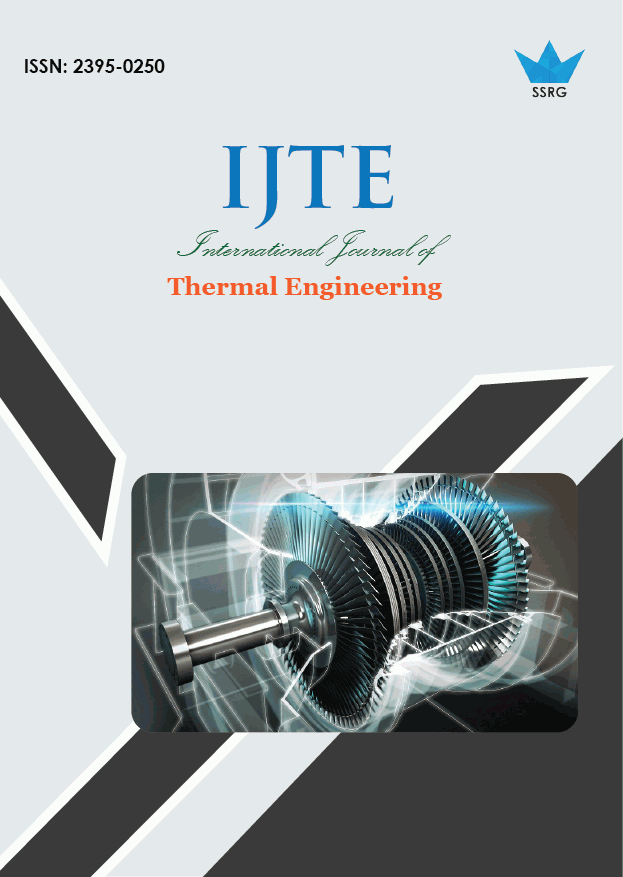Analysis of Combustion Characteristics of a LHR-STD Diesel Engine Fuelled with Biofuel and Diesel Fuel

| International Journal of Thermal Engineering |
| © 2017 by SSRG - IJTE Journal |
| Volume 3 Issue 1 |
| Year of Publication : 2017 |
| Authors : Selman Aydin, Cenk Sayin, Hüseyin Aydin, Rifat Yakut |
How to Cite?
Selman Aydin, Cenk Sayin, Hüseyin Aydin, Rifat Yakut, "Analysis of Combustion Characteristics of a LHR-STD Diesel Engine Fuelled with Biofuel and Diesel Fuel," SSRG International Journal of Thermal Engineering, vol. 3, no. 1, pp. 12-20, 2017. Crossref, https://doi.org/10.14445/23950250/IJTE-V3I1P103
Abstract:
It is important to efficiently use of alternative fuel in CI (compression ignition) engine, because of the lack of energy shortages will be in the present and coming years. Therefore this study, the top surfaces of the piston, exhaust and inlet valves of a four-stroke, direct injection, single cylinder CI engine was coated with a mixture of insulation materials by use of plasma spray method. After that, determine of combustion characteristics of standard (STD) CI engine and the low heat rejection (LHR) CI engine were tested under the same experimental conditions and the same experimental setup, fuelled with the WB20, WB100 and DF fuels. The results of both engines are compared with each other so that analyze how this modification is effect on the combustion parameters. Experimental results showed that LHR diesel engine generally is partly similar to STD diesel engine in terms of the knock density, mass burning rate, average gas temperature, velocity of heat transfer, coefficient of heat transfer and total heat transfer.
Keywords:
Combustion characteristics, Diesel engine, Low heat rejection, Waste cooking oil biofuel.
References:
[1] Assanis, D.N., 2012, “The effect of thin ceramic coatings on petrol engine performance and emissions”,Int. J. Veh. Des. 13 (4), 378–387.
[2] Rahman, S., Masjuki, H., Kalam, M., Abedin, M., Sanjid, A., Sajjad, H., 2013, “Production of palm and calophylluminophyllum based biodiesel and investigation of blend performance and exhaust emission in an unmodified diesel engine at high idling conditions”, Energy Conversion Management, 76, 362–7.
[3] Benson, R.S., Whitehouse, N.D., 1979, “Internal Combustion Engines, Pergamum Press”, Oxford [4] Ferguson, C.R., 1986, Internal Combustion Engines, John Wiley, New York.
[5] Heywood, J.B., 1988, Internal Combustion Engine Fundamentals, McGraw-Hill, New York.
[6] Obert, E.F., 1973, “Internal Combustion Engines and Air Pollution”, Intext Educational Publishers, New York.
[7] Gataowski, J.A., 1990, “Evaluation of a selectively- cooled single-cylinder 0.5-l Diesel engine” SAE paper No. 900693.
[8] Schwarz, E., Reid, M., Bryzik, W., 1993, Danielson E. Combustion and performance characteristics of a low heat rejection engine. SAE paper, No. 930988.
[9] Bryzik, W., Kamo, R., 1983, “Tacom/Cummins adiabatic engine program”. SAE paper No. 830314.
[10] Dhinagar, S.J., Nagalinga, B., Gopalakrishnan, K.V., 1992,“Spark assisted Diesel operation in a low compression ratio low heat rejection engine”, SAE paper No. 920245.
[11] Kawamura, H., Sekiyama, S., Hirai, K., 1991, “Observation of combustion process in a heat insulated engine”, SAE paper No. 910462.
[12] Hay, N., Watt, P.M., Ormerod, M.J., Burnett, G.P., Beesley, P.W., French, B.A., 1990, “Design study for a low heat loss version of the Dover engine”, Proc I Mech E 200, 53–60.
[13] Siegla, D.C., Amman, C.A., 1995, “Exploratory study of the low heat rejection Diesel for passenger car applications” SAE paper No. 840435.
[14] Beardsley, M.,Happoldt, P., Kelley, K., Rejda, E., Socie, D., 1999, “Thermalbarriercoatingsforlowemission, highefficiencydiesel engine applications”, SAE technicalpaper, 1999-01- 2255.
[15] Sun, X., Wang, W., Bata, R.,1994, “Performance evaluation of low heat rejection engines” ASME Transactions, 116, 758-64.
[16] Parlak, A., Yasar, H., Eldogan, O., 2005, “The effect of thermal barrier coating on a turbocharged diesel engine performance and exergy potential of the exhaust gas”, Energy Convers Manage, 46, 489–99.
[17] Aydin, H., 2013, “Combined effects of thermal barrier coating and blending with diesel fuel on usability of vegetable oils in diesel engines”, Applied Thermal Engineering, 51, 623-629.
[18] Musthafa, M.M., Sivapirakasam, S.P., Udayakumar, M., 2011, “Comparative studies on fly ash coated low heat rejection diesel engine on performance and emission characteristics fueled by rice bran and pongamia methyl ester and their blend with diesel”, Energy, 36(5), 2343-2351.
[19] Parlak, A., 2005, “The effect of heat transfer on performance of the Diesel cycle and exergyof the exhaust gas stream in a LHR diesel engine at the optimum injection timing”. Energy Convers. Manage., 46, 167–179.
[20] Aydin, S., Sayin, C.,2014, “Impact of thermal barrier coating application on the combustion, performance and emissions of a diesel engine fueled with waste cooking oil biodiesel– diesel blends”, Fuel, 136, 334-340.
[21] Brunt, M., Platts, K., 1999, “Calculation of Heat Release in Direct Injection Diesel Engines” SAE Technical Paper, 01-0187.
[22] Brunt, M.F.J., Rai, H., Emtage, A.L., 1998, “The calculation of heat release energy from cylinder pressure data”, SAE Paper No. 981052.
[23] Hohenberg, GH., 1979, “Advanced approaches for heat transfer calculations” SAE Paper No. 790825
[24] Checkel, M., Dale, J.,1986, “Computerized Knock Detection from Engine Pressure Records" SAE Technical Paper, 860028.
[25] Özener, O., Yüksek, L., Ergenç, A.T., Özkan, M., 2014, “Effects of soybean biodiesel on a DI diesel engine performance, emission and combustion characteristics”, Fuel, 115, 875-883.
[26] Ghojel, J., Honnery, D., 2005, “Heat release model for combustion of diesel oil emulsions in DI diesel engine”, Applied Thermal Engineering, 25,2027-2085.

 10.14445/23950250/IJTE-V3I1P103
10.14445/23950250/IJTE-V3I1P103